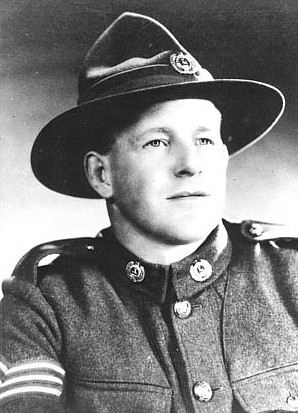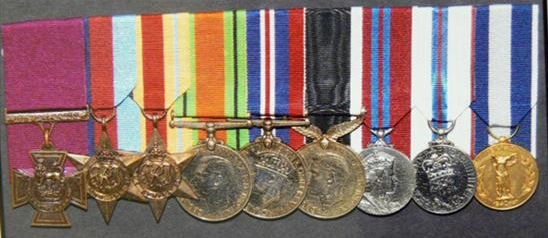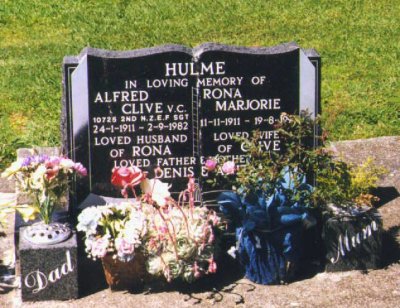



HULME Alfred Clive
10725, Sergeant, 23rd Battalion, 2nd New Zealand Division, WW2






 Clive HULME was born in 1911 in Dunedin and was a farmer until 1940. He moved to Nelson and married Rona Murcott there on 3 May 1934. They
Clive HULME was born in 1911 in Dunedin and was a farmer until 1940. He moved to Nelson and married Rona Murcott there on 3 May 1934. They






 had 2 children, a daughter and son Denis [Denny], born in 1936. Denis HULME was later to become a very successful Formula One racing car driver
had 2 children, a daughter and son Denis [Denny], born in 1936. Denis HULME was later to become a very successful Formula One racing car driver







 At the outbreak of the Second World War, Clive HULME was working as a farm labourer in Nelson and he enlisted on 22 January 1940. During
At the outbreak of the Second World War, Clive HULME was working as a farm labourer in Nelson and he enlisted on 22 January 1940. During






 training he was promoted to the rank of corporal and he left New Zealand on 1 May 1940 with the 23rd Battalion as part of the Second Echelon. He was
training he was promoted to the rank of corporal and he left New Zealand on 1 May 1940 with the 23rd Battalion as part of the Second Echelon. He was






 promoted to sergeant at sea.
promoted to sergeant at sea.







 The 23rd Battalion was diverted to England and stationed there during the Battle of Britain. They joined the Second New Zealand Division in March
The 23rd Battalion was diverted to England and stationed there during the Battle of Britain. They joined the Second New Zealand Division in March






 1941 shortly before the New Zealanders' first engagements on the battlefields of Greece and Crete.
1941 shortly before the New Zealanders' first engagements on the battlefields of Greece and Crete.







 Sergeant HULME took part in the action at Maleme Airport in Crete where he led a series of counter attacks against pockets of German
Sergeant HULME took part in the action at Maleme Airport in Crete where he led a series of counter attacks against pockets of German






 paratroopers and he later led his men during the counter attack at Galatos. He stalked and killed 33 enemy snipers and his courage amazed his fellow
paratroopers and he later led his men during the counter attack at Galatos. He stalked and killed 33 enemy snipers and his courage amazed his fellow






 soldiers. He was severely wounded in the shoulder while stalking another sniper and was ordered to the rear. In spite of his wound, he directed traffic
soldiers. He was severely wounded in the shoulder while stalking another sniper and was ordered to the rear. In spite of his wound, he directed traffic






 under fire and organized stragglers of various units into section groups. He was awarded the VC. for his service in Crete.
under fire and organized stragglers of various units into section groups. He was awarded the VC. for his service in Crete.







 Sergeant HULME died at Te Puke on 2 September, 1982, and is buried at the Dudley Cemetery, Te Puke, New Zealand.
Sergeant HULME died at Te Puke on 2 September, 1982, and is buried at the Dudley Cemetery, Te Puke, New Zealand.







 His Victoria Cross is held at the Queen Elizabeth II Army Memorial Museum, Waiouru, New Zealand.
His Victoria Cross is held at the Queen Elizabeth II Army Memorial Museum, Waiouru, New Zealand.
CITATION
Victoria Cross
Gazetted 10 October 1941, Supp 35306, p5936
Serjeant Hulme exhibited most outstanding and inspiring qualities of leadership, initiative; skill, endurance and most conspicuous gallantry and devotion to duty from the commencement of the heavy fighting in CRETE, on 20th May, 1941, until he was wounded in action 28th May, 1941. On ground overlooking MALEME Aerodrome on 20th and 2ist May he personally led parties of his men from the area held by the forward position and destroyed 'enemy organised parties who had established themselves out in front of our position, from which they brought heavy rifle, machine-gun and mortar fire to bear on our defensive posts. Numerous snipers in this area were dealt with by Serjeant Hulme personally; 130 dead were counted here. On 22nd, 23rd and 24th May Serjeant Hulme was continually going out alone or with one or two men and destroying enemy snipers. On 25th May, when Serjeant Hulme had rejoined his Battalion, this unit counter-attacked GALATOS village. The attack was partially held up by a large party of the enemy holding the school, from which they were inflicting heavy casualties on our troops. Serjeant Hulme went forward alone, threw grenades into the school and so disorganised the defence, that the counterattack was able to proceed successfully.
 On Tuesday, 27th May, when our troops were holding a defensive line at SUDA BAY during the final retirement, five enemy snipers had worked into position on the hillside overlooking the flank of the Battalion line. Serjeant Hulme volunteered to deal with the situation, and stalked and killed the snipers in turn. He continued similar work successfully through the day.
On Tuesday, 27th May, when our troops were holding a defensive line at SUDA BAY during the final retirement, five enemy snipers had worked into position on the hillside overlooking the flank of the Battalion line. Serjeant Hulme volunteered to deal with the situation, and stalked and killed the snipers in turn. He continued similar work successfully through the day.
 On 28th May at STYLOS, when an enemy heavy mortar was severely bombing a very important ridge held by the Battalion rearguard troops, inflicting severe casualties, Serjeant Hulme, on his own initiative, penetrated the enemy lines, killed the mortar crew of four, put the mortar out of action, and thus very materially assisted the withdrawal of the main body through STYLOS. From the enemy mortar position he then worked to the left flank and killed three snipers who were causing concern to the rearguard. This made his score of enemy snipers 33 stalked and shot. Shortly afterwards Serjeant Hulme was severely wounded in the shoulder whilst stalking another sniper. When ordered to the rear, in spite of his wound, he directed traffic under fire and organised stragglers of various units into section groups.
On 28th May at STYLOS, when an enemy heavy mortar was severely bombing a very important ridge held by the Battalion rearguard troops, inflicting severe casualties, Serjeant Hulme, on his own initiative, penetrated the enemy lines, killed the mortar crew of four, put the mortar out of action, and thus very materially assisted the withdrawal of the main body through STYLOS. From the enemy mortar position he then worked to the left flank and killed three snipers who were causing concern to the rearguard. This made his score of enemy snipers 33 stalked and shot. Shortly afterwards Serjeant Hulme was severely wounded in the shoulder whilst stalking another sniper. When ordered to the rear, in spite of his wound, he directed traffic under fire and organised stragglers of various units into section groups.
KNOWN AWARDS
Victoria Cross
1939-45 Star
Africa Star
Defence Medal
War Medal 1939-45
New Zealand War Service Medal
Coronation Medal 1953
Silver Jubilee Medal 1977
Greek Medal for Crete





